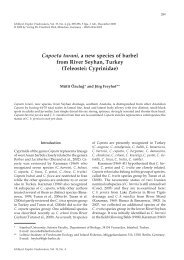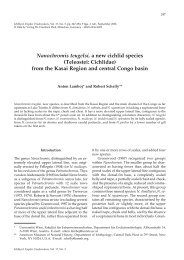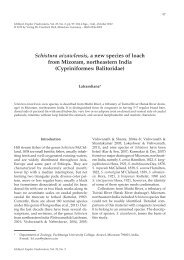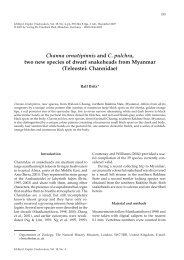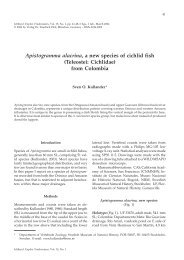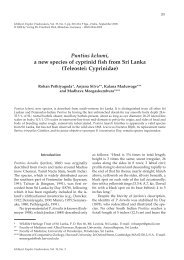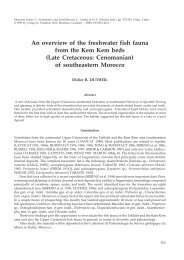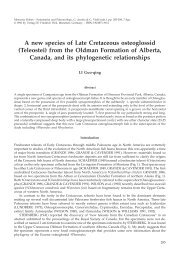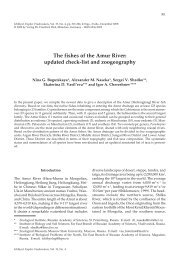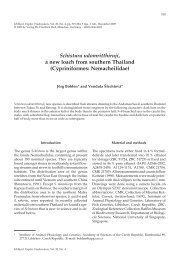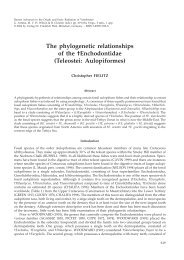Overview of systematics, paleobiology, and paleoecology of Triassic ...
Overview of systematics, paleobiology, and paleoecology of Triassic ...
Overview of systematics, paleobiology, and paleoecology of Triassic ...
Create successful ePaper yourself
Turn your PDF publications into a flip-book with our unique Google optimized e-Paper software.
Mesozoic Fishes – Systematics <strong>and</strong> Paleoecology, G. Arratia & G. Viohl (eds.): pp. 479-500, 13 figs., 1 tab., 1 app.<br />
© 1996 by Verlag Dr. Friedrich Pfeil, München, Germany – ISBN 3-923871–90–2<br />
<strong>Overview</strong> <strong>of</strong> <strong>systematics</strong>, <strong>paleobiology</strong>,<br />
<strong>and</strong> <strong>paleoecology</strong> <strong>of</strong> <strong>Triassic</strong> fishes<br />
<strong>of</strong> northwestern Madagascar<br />
Laurence BELTAN<br />
Abstract<br />
Several <strong>Triassic</strong> fossil-bearing beds from northwestern Madagascar have yielded abundant ichthy<strong>of</strong>aunas which<br />
have been studied from different points <strong>of</strong> view, e.g., <strong>systematics</strong>, <strong>paleobiology</strong>, <strong>and</strong> <strong>paleoecology</strong>. An overview<br />
<strong>of</strong> these findings is presented here. Thirty-six species <strong>of</strong> actinopterygian <strong>and</strong> sarcopterygian fishes have been<br />
recovered. The fishes lived in marine water, in a semi-arid environment, with other vertebrates, invertebrates, <strong>and</strong><br />
plants. Chemical reactions have been instigated between these <strong>Triassic</strong> sediments, derived from the nearby crystalline<br />
massifs, <strong>and</strong> biotas embedded in those. The result is that the taphonomy is uncommon, <strong>and</strong> the aspect<br />
observed in the outcrops does not reflect the <strong>paleoecology</strong>, that is to say, the biotopes <strong>of</strong> living fishes.<br />
Introduction<br />
A geological research in the north <strong>of</strong> Madagascar, in the Diego Basin (Fig. 1), was firstly attempted at the<br />
beginning <strong>of</strong> this century. Among other deposits, those from the <strong>Triassic</strong> have yielded an important paleontological<br />
material, particularly ichthy<strong>of</strong>auna. The first description <strong>of</strong> actinopterygians, from l’Andavakoera,<br />
were by MERLE (1908), <strong>and</strong> <strong>of</strong> coelacanthids, by WOODWARD (1910). These papers were the<br />
prelude to a long series <strong>of</strong> publications concerning this abundant <strong>Triassic</strong> ichthy<strong>of</strong>auna from northwestern<br />
Madagascar (PRIEM 1924, WHITE 1933, PIVETEAU 1934, 1944, MOY-THOMAS 1935, LEHMAN 1952,<br />
1956, BELTAN 1957, 1958, 1963, 1968, 1977, 1980a, b, 1984, <strong>and</strong> others). The abundance <strong>of</strong> material allowed<br />
detailed anatomical descriptions <strong>of</strong> genera as Perleidus, Watsonulus, Parasemionotus, Saurichthys, <strong>and</strong> Australosomus,<br />
including restorations <strong>of</strong> skull ro<strong>of</strong> bones, cheek patterns, opercular apparatuses, suspensoria,<br />
<strong>and</strong> even the cephalobranchial circulatory apparatus <strong>of</strong> Australosomus (PIVETEAU 1934, LEHMAN 1952,<br />
1956, BELTAN 1968, OLSEN 1984).<br />
In addition to these studies on the fish fauna, other publications about the northwestern Madagascar<br />
outcrops include other vertebrate faunas (e.g., stegocephalians by LEHMAN 1961, 1979a; proanurans by<br />
RAGE & ROCECK 1989; eosuchians by LEHMAN 1966), plants <strong>and</strong> invertebrates (e.g., ammonites by<br />
COLLIGNON 1933, 1934; corals <strong>and</strong> molluscs by BESAIRE 1972), geology (e.g., BESAIRE & COLLIGNON<br />
1956, BESAIRE 1972, BRENON 1972, BATTAIL et al. 1987), taphonomy (e.g., BESAIRE 1972), <strong>and</strong> paleobiological<br />
<strong>and</strong> paleoecological aspects (e.g., LEHMAN 1952, 1956, BELTAN 1977, 1980a, b, 1984).<br />
The main goals <strong>of</strong> this contribution are (1) to summarize the knowledge about geology, taphonomy,<br />
<strong>systematics</strong>, <strong>paleoecology</strong>, <strong>and</strong> <strong>paleobiology</strong> <strong>of</strong> the fossil-bearing <strong>Triassic</strong> beds from northwestern Madagascar<br />
<strong>and</strong> (2) to present an insight on the taphonomy (mostly concerning the formation <strong>of</strong> fossiliferous<br />
nodules).<br />
First, the general geographic <strong>and</strong> geological backgrounds <strong>of</strong> the <strong>Triassic</strong> fish localities from northwestern<br />
Madagascar are presented, including a list <strong>of</strong> the main outcrops. This is followed by an explanation <strong>of</strong><br />
some taphonomic processess, including a hypothesis on the formation <strong>of</strong> the siliceous-clayed, non-calcareous<br />
fossil-bearing nodules. Then, some considerations on the anatomy <strong>and</strong> <strong>systematics</strong> <strong>of</strong> the ichthy<strong>of</strong>auna<br />
are presented, including an appendix with the complete list <strong>of</strong> the fishes known from these localities.<br />
Finally, some paleoecological <strong>and</strong> paleobiological aspects are briefly discussed.<br />
479
The whole contribution can be<br />
purchased as PDF file.<br />
Availability<br />
Generally all our publications are available as PDF fi les;<br />
full publications as a general rule after the printed version<br />
is out <strong>of</strong> print. If you have questions concerning particular<br />
contributions please contact us by e-mail:<br />
pdf@pfeil-verlag.de.<br />
The PDF files are protected by copyright.<br />
The PDF fi le may be printed for personal use.<br />
The reproduction <strong>and</strong> dissemination <strong>of</strong> the content or<br />
part <strong>of</strong> it is permitted.<br />
It is not allowed to transfer the digital personal certifi cate<br />
or the password to other persons.<br />
Prices<br />
Books: Prices are to be found in the catalog.<br />
Articles in journals <strong>and</strong> single contributions or chapters<br />
in books:<br />
10 EURO basic price per order (including the fi rst 10<br />
pages),<br />
<strong>and</strong><br />
0.50 EURO per page, beginning with the 11 th page.<br />
Page numbers are found in the contents <strong>of</strong> the publications.<br />
Orders<br />
Use our order form for PDF fi les or send your order informal<br />
per e-mail (pdf@pfeil-verlag.de). The only accepted<br />
payment is by credit card. While using the order<br />
form for PDF files, your data will be transmitted by secure<br />
link (ssl). You also may send the informations informally<br />
by e-mail, fax, phone or mail.<br />
H<strong>and</strong>ling<br />
As soon as possible, depending on our business hours<br />
<strong>and</strong> your order, you will receive your PDF fi le together<br />
with the certifi cate <strong>and</strong> password by e-mail.<br />
Larger PDF files can be downloaded from our webspace,<br />
if necessary.<br />
Your invoice will be sent out by e-mail after we charged<br />
your credit card.<br />
To open the encrypted PDF fi les you have to install your<br />
personal certifi cate after your fi rst order. All PDF fi les<br />
with the same certifi cate can be opened from that time<br />
on.<br />
Dieser Beitrag kann als<br />
PDF-Datei erworben werden.<br />
Verfügbarkeit von PDF-Dateien<br />
Prinzipiell sind von allen unseren Publikationen PDF-<br />
Dateien erhältlich. Komplette Publikationen in der Regel<br />
erst nachdem die gedruckte Version vergriffen ist. Anfragen<br />
bezüglich bestimmter Beiträge richten Sie bitte<br />
per E-Mail an pdf@pfeil-verlag.de.<br />
Die PDF-Dateien sind urheberrechtlich geschützt.<br />
Ein Ausdruck der PDF-Dateien ist nur für den persönlichen<br />
Gebrauch erlaubt.<br />
Die Vervielfältigung von Ausdrucken, erneutes Digitalisieren<br />
sowie die Weitergabe von Texten und Abbildungen<br />
sind nicht gestattet.<br />
Das persönliche Zertifikat und das Passwort dürfen nicht<br />
an Dritte weitergegeben werden.<br />
Preise<br />
Bücher: Die Preise sind dem Katalog zu entnehmen.<br />
Zeitschriftenbeiträge und einzelne Kapitel aus Sammelbänden<br />
bzw. Büchern:<br />
10 EURO Grundbetrag pro Bestellung (einschließlich<br />
der ersten 10 Seiten),<br />
und<br />
0,50 EURO pro Seite ab der 11. Seite.<br />
Den Umfang der Beiträge entnehmen Sie bitte den Inhaltsverzeichnissen.<br />
Bestellungen<br />
Bestellungen sind mit dem PDF-Bestellformular oder<br />
formlos per E-Mail (pdf@pfeil-verlag.de) an uns zu<br />
richten. Die Bezahlung ist ausschließlich per Kreditkarte<br />
möglich. Bei Verwendung unseres Bestellformulars<br />
werden die Kreditkartendaten über eine gesicherte<br />
Verbindung (ssl) übermittelt. Sie können die Daten aber<br />
auch formlos per E-Mail, Fax, Post oder telefonisch<br />
übermitteln.<br />
Abwicklung<br />
So bald wie möglich, aber abhängig von unseren Bürozeiten<br />
und der gewünschten Bestellung, schicken wir<br />
Ihnen die PDF-Datei(en) zusammen mit Ihrem persönlichen<br />
Zertifi kat und dem zugehörigem Passwort per<br />
E-Mail. Größere Dateien bieten wir Ihnen gegebenenfalls<br />
zum Herunterladen an.<br />
Der fällige Betrag wird von Ihrer Kreditkarte abgebucht<br />
und Sie erhalten die Rechnung ebenfalls per E-Mail.<br />
Um die verschlüsselten PDF-Dateien öffnen zu können,<br />
muss bei der ersten Bestellung das passwortgeschützte<br />
persönliches Zertifi kat installiert werden, welches<br />
anschließend auf dem Rechner verbleibt. Alle mit diesem<br />
Zertifi kat verschlüsselten Dateien können anschließend<br />
auf diesem Rechner geöffnet werden.




